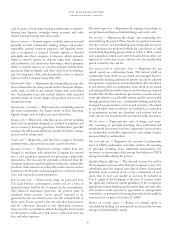American Express 2008 Annual Report Download - page 61
Download and view the complete annual report
Please find page 61 of the 2008 American Express annual report below. You can navigate through the pages in the report by either clicking on the pages listed below, or by using the keyword search tool below to find specific information within the annual report.2008 financial review
american express company
Return on average tangible equity — Return on average tangible
equity is computed in the same manner as return on average
equity except the computation of average tangible shareholders’
equity excludes average goodwill and other intangibles.
Return on average segment capital — Return on average segment
capital is calculated by dividing one year period segment income
by one year average segment capital.
Return on average tangible segment capital — Return on average
tangible segment capital is computed in the same manner as
return on average segment capital except the computation of
average tangible segment capital excludes average goodwill and
other intangibles.
Risk-weighted assets — Risk-weighted assets are assets weighted
for risk according to a formula used by the Federal Reserve Board
to conform to capital adequacy guidelines. On and off-balance
sheet items are weighted for risk, with off-balance sheet items
converted to balance sheet equivalents, using risk conversion
factors, before being allocated a risk-adjusted weight.
Securitization income, net — Includes non-credit provision
components of the net gains or losses from securitization activities;
changes in fair value of the interest-only strip; excess spread
related to securitized cardmember loans; and servicing income,
net of related discounts or fees. Excess spread, which is recognized
as earned, is the net cash flow from interest and fee collections
allocated to the third-party investors’ interests in the securitization
after deducting the interest paid on the investor certificates, credit
losses, contractual servicing fees, and other expenses.
Stored value and prepaid products — Includes Travelers Cheques
and other prepaid products such as gift cheques and cards as well
as reloadable Travelers Cheque cards. These products are sold
as safe and convenient alternatives to currency for purchasing
goods and services.
Tier 1 capital ratio — Tier 1 capital ratio is calculated as Tier 1
capital divided by risk-weighted assets. Tier 1 capital is the sum
of common stockholders’ equity, certain perpetual preferred
stock, and minority interests in consolidated subsidiaries,
adjusted for certain other comprehensive income items,
ineligible goodwill and intangible assets. This ratio is commonly
used by regulatory agencies to assess a financial institution’s
financial strength and is the primary form of capital used to
absorb losses beyond current loss accrual estimates.
Tier 1 leverage ratio — Tier 1 leverage ratio is calculated by
dividing Tier 1 capital (as defined above) by its average total
consolidated assets for the most recent quarter.
Total cards-in-force — Represents the number of cards that
are issued and outstanding. Total consumer cards-in-force
includes basic cards issued to the primary account owner and
any supplemental cards, which represent additional cards issued
on that account. Total small business and corporate cards-in-
force include basic cards issued to employee cardmembers.
Proprietary cards-in-force represent card products where the
Company owns the cardmember relationship including card
issuance, billing and credit management and strategic plans
such as marketing, promotion, and development of card
products and offerings. Proprietary cards-in-force include co-
brand and affinity cards. For non-proprietary cards-in-force
(except for certain independent operator network partnership
agreements), the Company maintains the responsibility to
acquire and service merchants that accept the Company’s cards
and the cardmember relationship is owned by the Company’s
network partners that issue the cards.
Total risk-based capital ratio — Total risk-based capital ratio is
calculated as the sum of Tier 1 capital (as defined above) and
Tier 2 capital divided by risk-weighted assets. The Company
calculates Tier 2 capital as the sum of the allowance for receivable
and loan losses (limited to 1.25 percent of risk-weighted assets)
and 45 percent of the unrealized gains on equity securities.
Travel sales — Represents the total dollar amount of travel
transaction volume for airline, hotel, car rental, and other travel
arrangements made for consumers and corporate clients. The
Company earns revenue on these transactions by charging a
transaction or management fee.
forward-looking statements
This report includes forward-looking statements, which are
subject to risks and uncertainties. The forward-looking
statements, which address the Company’s expected business and
financial performance, among other matters, contain words such
as “believe,” “expect,” “anticipate,” “optimistic,” “intend,” “plan,”
“aim,” “will,” “may,” “should,” “could,” “would,” “likely,” and
similar expressions. Readers are cautioned not to place undue
reliance on these forward-looking statements, which speak only
as of the date on which they are made. The Company undertakes
no obligation to update or revise any forward-looking statements.
Factors that could cause actual results to differ materially from
these forward-looking statements include, but are not limited to,
the following: consumer and business spending on the Company’s
credit and charge card products and Travelers Cheques and other
prepaid products and growth in card lending balances, which
depend in part on the economic environment, and the ability to
issue new and enhanced card and prepaid products, services and
rewards programs, and increase revenues from such products,
attract new Cardmembers, reduce Cardmember attrition, capture
a greater share of existing Cardmembers’ spending, and sustain
premium discount rates on its card products in light of regulatory
and market pressures, increase merchant coverage, retain
Cardmembers after low introductory lending rates have expired,
and expand the Global Network Services business; the Company’s
ability to manage credit risk related to consumer debt, business
loans, merchants and other credit trends, which will depend in
part on the economic environment, including, among other
things, the housing market, the rates of bankruptcies and
unemployment, which can affect spending on card products,
debt payments by individual and corporate customers and
59
























